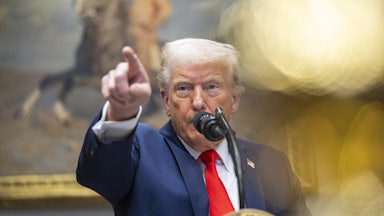Last week, on 60 Minutes+, journalist Wesley Lowery visited Manhattan Beach, California, to cover a century-old story about a Black family trying to reclaim beachfront property that had been stolen from their ancestors by white people and the Los Angeles city government. A white resident interviewed by Lowery cautioned against any retributive action by asking a series of—in his mind—entirely hypothetical questions. “How are we going to address that as a country?” the man asked. “And can you keep going and going, right? Are we going to give everyone that lost their land through some unjust means—is that going to happen? Are we going to go all the way back to Native Americans and Indigenous people? Where does that stop?”
For decades, these final two questions have served as the ultimate retort for Americans who refuse to look backward for progress. They have similarly bedeviled every administration since Richard Nixon, the first modern president to acknowledge that tribal nations were sovereign entities that not only deserve the same respect allotted to foreign governments but are entitled to some of the land that was stolen from them, too. Today, the questions posed by that Manhattan Beach man are not nearly as hypothetical as he and many others believe. To the contrary, the land back movement—which seeks to return land to Indigenous people—might just find its way into federal policy, one plan at a time.
On Thursday, the Biden administration released a plan that calls for conserving 30 percent of the land and water under U.S. and tribal jurisdiction by 2030. The 24-page document recognizes the need for bottom-up resource management, makes both the economic and environmental cases for better stewardship of the earth, and underscores the need to uphold strong private property rights (an attempt, perhaps, to neutralize criticism from far-right politicians like Congresswoman Lauren Boebert, who called the plan a “radical … land grab” before she’d even seen the details). But what makes Biden’s plan truly remarkable—at least in theory—is how thoroughly it highlights why tribal sovereignty is not just a treaty-held right for federal agencies to acknowledge but a crucial part of preserving the planet.
The plan’s opening salvo, titled “Letter to America,” is written by three Cabinet members—Interior’s Deb Haaland, Agriculture’s Tom Vilsack, Commerce’s Gina Raimondo—and Brenda Mallory, the chair of the White House Council on Environmental Quality. The authors note how, since federal conservation efforts first began, the measures of success largely have been defined quantitatively. That is, the federal government’s concern has focused more on, say, how many national parks are being maintained and how many park visitors are visiting them, as opposed to how these lands are being managed and by whom.
In their letter, the Cabinet members have chosen an alternate route. They write that among many different qualifications, a successful conservation effort can and should be defined by “the leadership of sovereign Tribal Nations in caring for lands, waters, and wildlife.” The reason for this, as the plan states in a list of principles, is that tribal nations continue to maintain and strengthen their political and legal sovereignty over their lands and waters. If Biden and future administrations are going to learn from America’s mistakes and craft a viable path to sustainability, this simple acknowledgment must be the foundation they build it on.
As the Supreme Court held last summer in its landmark McGirt ruling, Indian Country—the broad term used to cover the collective of tribal nations—is not a concrete entity. Rather, the borders of tribal nations, repeatedly hemmed in by duplicitous colonizing powers, now have the ability to grow, depending on the limited cooperation of American courts and governments. The number of tribal nations also has the ability to grow, by way of the Interior Department’s federal recognition process. In the last three years, tribes in Virginia and Montana have had their sovereign status recognized by either Congress or the Interior. (Plenty of others, like the Chinook and Lumbee, have been forced for years to wait while an endless stream of politicians make the same empty promise.)
The Trump administration often chose to block such growth in favor of groveling to extractive industry. Though Trump approved the federal recognition of the Virginia tribes and the Little Shell Tribe of Chippewa Indians, his Interior took just 75,000 acres of land into trust for tribal nations, compared to the 570,000-acre mark set by the Obama administration, according to Indian Country Today. The Biden administration is now opting to make the fee-to-trust path—the process by which private lands held by tribes or tribal citizens are taken into trust by the U.S., allowing tribal governments to exercise their jurisdictional authority on those lands—clearer. In late April, Haaland issued a department-wide order instructing regional directors in the Bureau of Indian Affairs to begin reviewing trust applications. The update was an attempt to expedite a process that previously could take years, as trust applications were previously funneled through the Interior’s brass instead.
It is impossible to separate these kinds of moves from the Biden conservation plan, because they are the plan. Indigenous land and water stewardship stands out as one of the most direct pathways to preserving and encouraging biological diversity. From butterflies to wolves to rivers, tribal nations have consistently created management plans and legal frameworks that provide a path that goes beyond the hands-off conservationism of the past and charts a course for sustainable cohabitation.
The next step, after shoring up the federal recognition and streamlining the land-into-trust process, is clear: American agencies and corporations must be held accountable for their failure to consult with tribal governments about their actions on Indigenous lands. As tribal leaders and the U.S. government’s own watchdogs have said for decades, the tribal consultation process—wherein nontribal entities must meet and work out an agreement for any developments or projects on tribal lands—is deeply broken. Without a consultation process in place that guarantees that tribal nations will be allowed to determine the future of their lands and waters, and not just retroactively sue for what others do to them, any accompanying efforts of land repatriation will be hollow. That’s why the Biden conservation plan reminds federal agencies that, in order to satisfy the plan’s call to support tribal nations and Indigenous communities, all agencies must take up “regular, meaningful, and robust consultation with Tribal Nations.”
I am not positing that all members of the Biden Cabinet are #LandBack allies. They’re not. But, by way of this plan, the administration has set the tone for what the next three-plus years must entail: Broken treaties and land agreements must be upheld; tribes need to be allowed to lead on resource management; and those who have been left on the outside need to be brought into the fold. If the administration accomplishes even a fraction of that, then Indian Country, the U.S., and the rest of the planet will be better for it.








